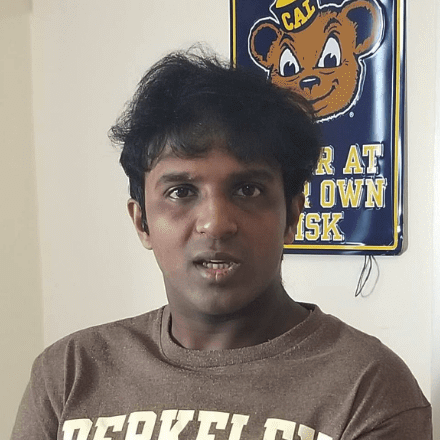
ABOUT
Hari Srinivasan is a minimally-speaking autistic at UC Berkeley majoring in psychology and minoring in Disability Studies. At Berkeley, he is lead instructor for a semester-long class on autism, is the first nonspeaking president of the student org, Spectrum at Cal, writes for the Daily Californian and is an RA at the university Psychology Labs as well as the UC Berkeley Disability Lab.
Hari’s Twitter →
I first heard about the Berkeley Disability Lab when I’d asked Prof Karen Nakamura for comments for an article I was writing. At that time she’d mentioned her lab and invited me to come visit.
The idea of a disability lab here at Cal intrigued me to no end. I wondered why I, as a person with a disability (autism), had not heard of it before. I came to the conclusion that like some of the disability-related resources at Cal, either you find it by accident or you graduate Cal without learning of its existence. The lab, started in 2018, was another well-kept secret much like the existence of disability student organizations or even autism student organizations on campus.
What is incredulous to me is that I even wrote a column on autism, “The Person Inside,” for the Daily Cal during my second semester, yet never knew of the existence of the “Spectrum: Autism at Cal” student organization at Cal till my 3rd semester and that too because I stumbled upon the Spectrum booth on Sproul Plaza quite by accident. And only when I took Prof. Victor Pineda’s City Planning and Public Policy class did I learn that there were actually other disability student bodies on campus.
Alas, my state of autism is nebulous with its yo-yo of moods and anxiety so it was not until this semester had started did I make it to the Disability lab. I loved that a new rule was immediately added to the list of community rules for the lab, which went “Stimming is Ok.” Though Karen and lab manager Nate Tilton (who is also the parent of an autistic child) got it, I think it left a lot of my neurotypical peers there quite puzzled and confused. Wanting to be PC I think they did not quite know how to ask what stimming was either.
To elucidate, those rather off-beat body mannerisms and behaviors that you see me (or many other autistics) doing are referred to as stims (short for self-stimulatory behaviors). Stims are often due to differences in sensory regulation, which means that I often experience my environment in a different and quite extraordinary way. My sensory system can almost be hyper-aware and hyper-react to all sorts of environmental input (Daily Cal Article: Sensory Walkabout) from sounds to lights, crowds, the the weather and even the smell of some foods. Plus add on some obsessive compulsive behaviors and a dab of anxiety; the result is a veritable smorgasbord of stim body movements which are also coping mechanisms of sorts. Much of this stimming are involuntary and only increase when people stare. The level of stims themselves varies across autistics, to an extent that it’s barely noticeable in some to the very obvious stimming like in my case. Most autistics that have traditionally made it to colleges are “speaking” and much more “put-together” than me, so I am not altogether surprised at the reaction and puzzlement from my peers at Cal and in the lab.
The lab does some pretty amazing out-of-the-box thinking for accessibility. As Karen says we want to also enable people who just want to change the world but currently find all the tools to do so inaccessible on so many levels. It is rather humbling to be in a place that is serious about potential hacks and low cost solutions that can help the disabled community. I usually find that if the word “special-needs,” “disabled,”or “accessible” is attached to a product, the cost is usually double or triple.
Still, I wondered about my role in the lab and how I could contribute. While the lab did aim to help find solutions for those will less fine motor dexterity, my fellow students in the lab creating those solutions did not obviously seem to lack fine motor dexterity. With my poor fine motor skills and my oft times uncoordinated body movements, I have struggled with even simple tasks like lego building in the past – the pieces were too tiny and it was very hard to pry them apart even though I did ask for the Harry Potter Hogwarts Train Lego set long back. My fine motor challenges have been a considerable source of frustration over the years – no handwriting skill means the inability to do the rough work required for much of the math and science problems; it compounds the non-speaking part. I have the cognitive ability but also have oral & motor apraxia which limit exploring STEM, which I would have dearly loved.
How would I be able to do any of the required tasks all of which seemed to require a good deal of fine motor skills? I thought maybe I would just be the ideas guy in the group, a role I have taken on in the past.
However, Karen quickly found a niche for me that takes advantage of my writing skill set and continue to give ideas- with Team Propaganda where I can both contribute ideas and write about what the lab is doing. She essentially tailored a new role for me. A Happy Ending!! So thank you Karen, for enabling me to be a contributing and productive member of the lab team.

Published by